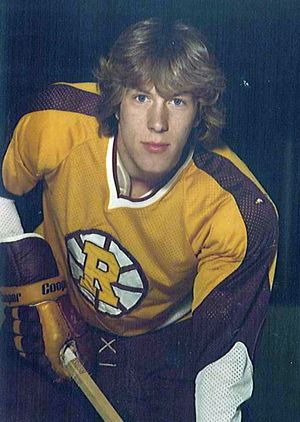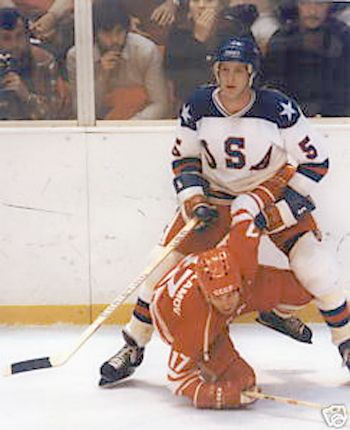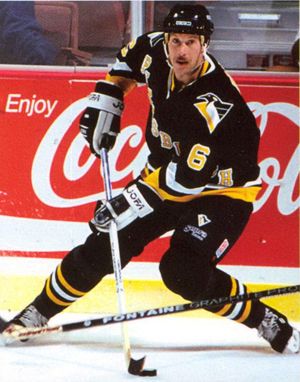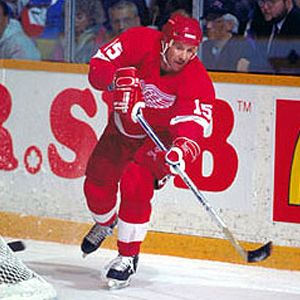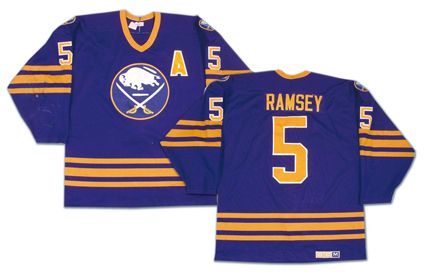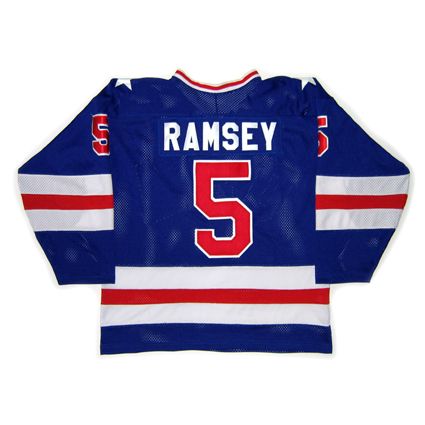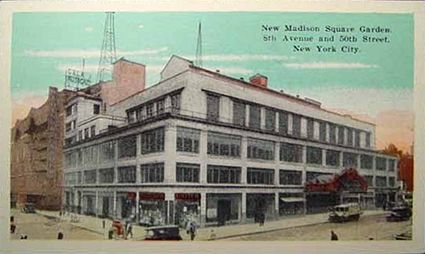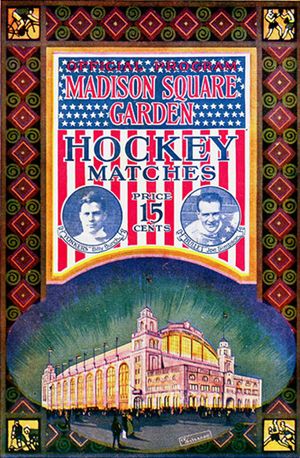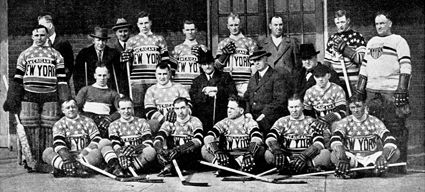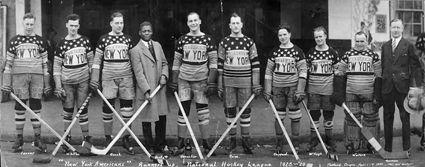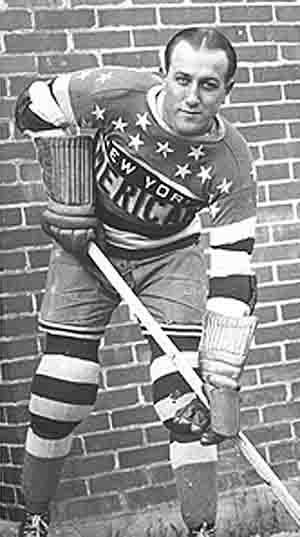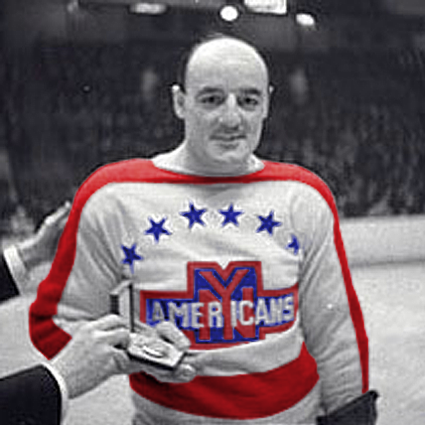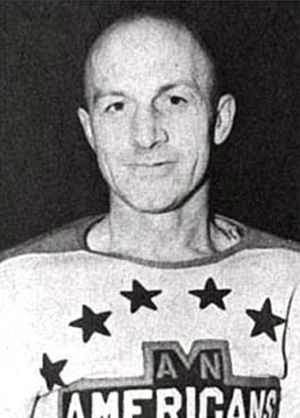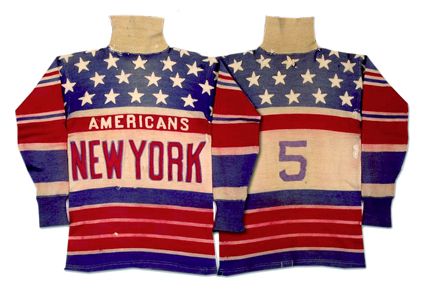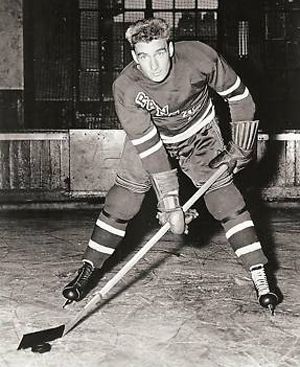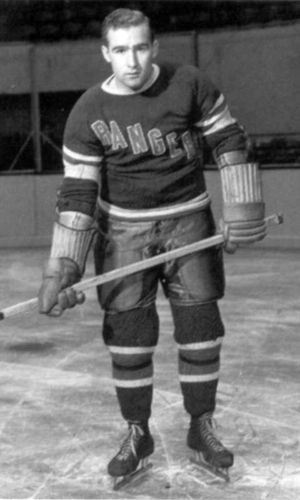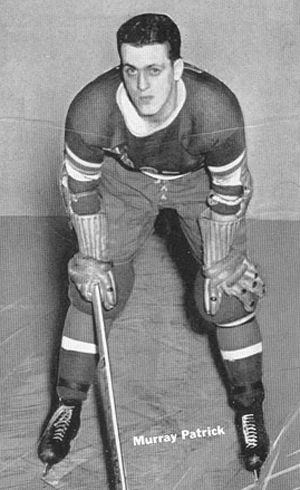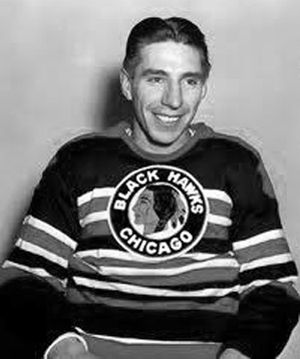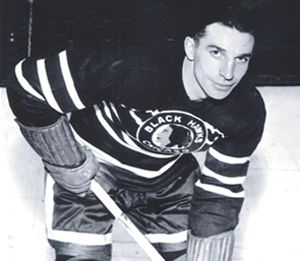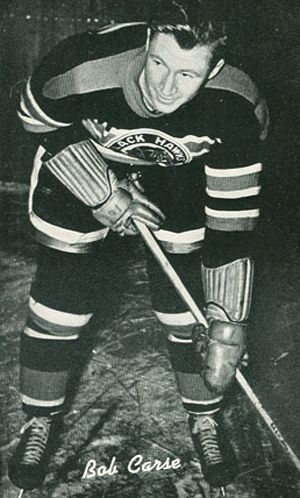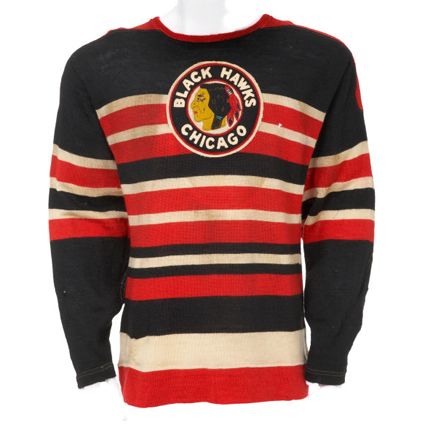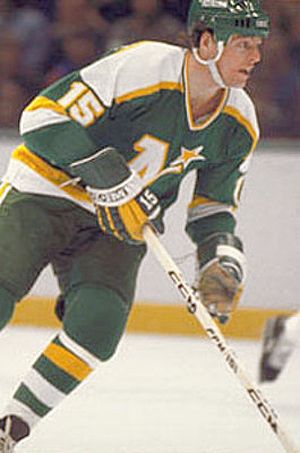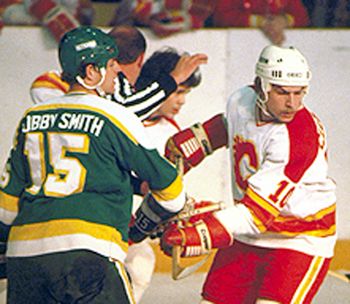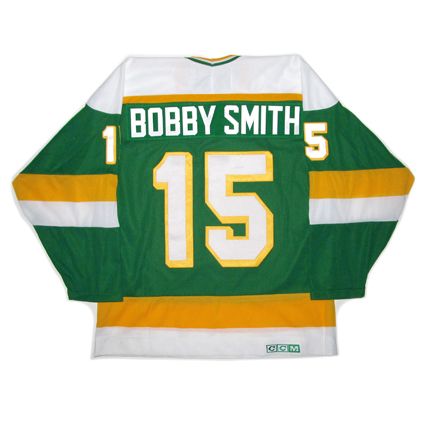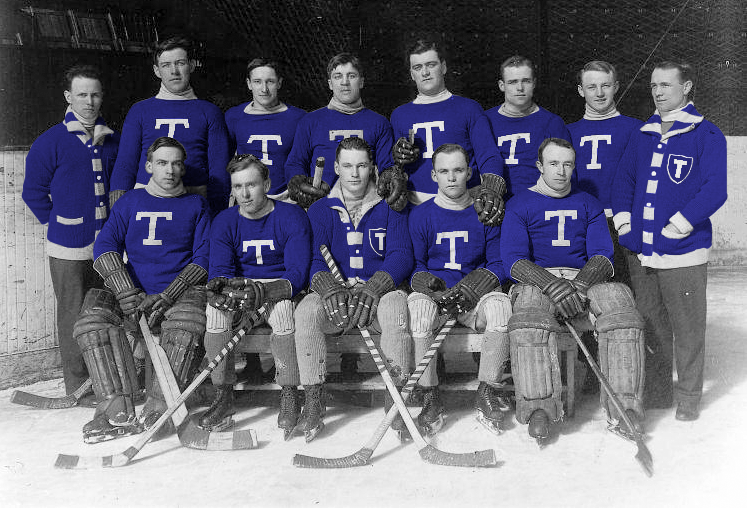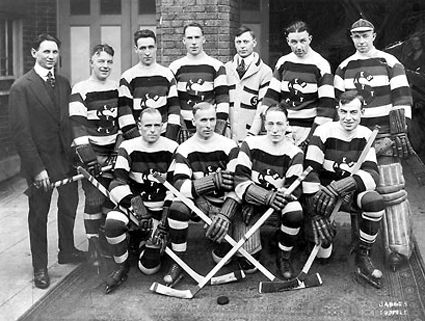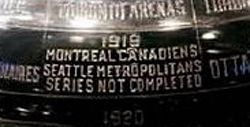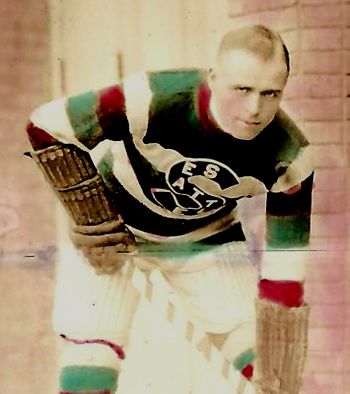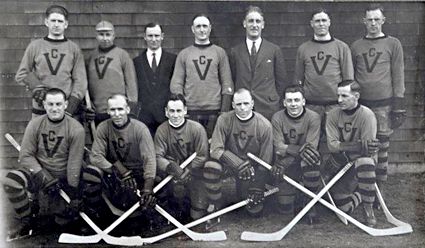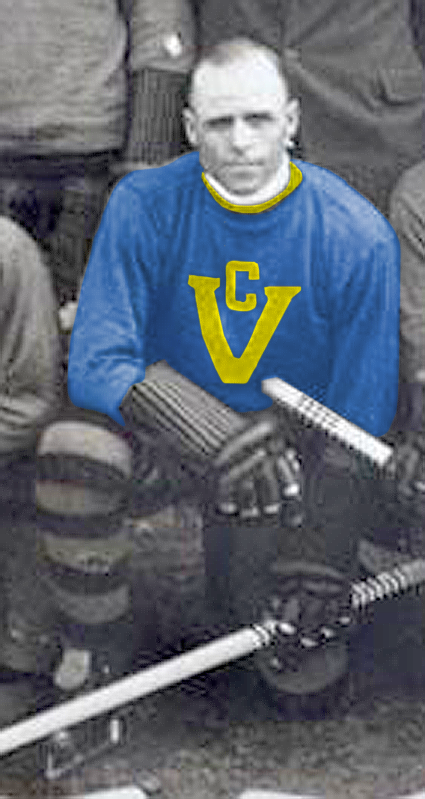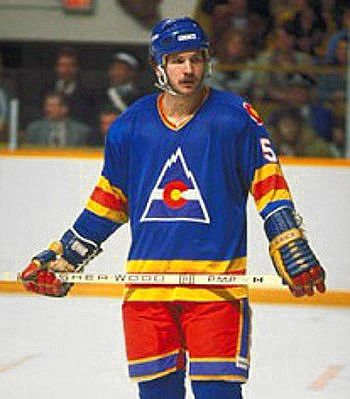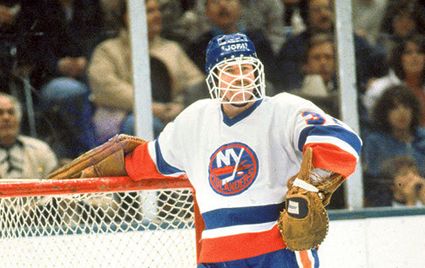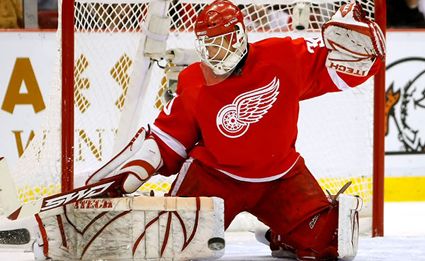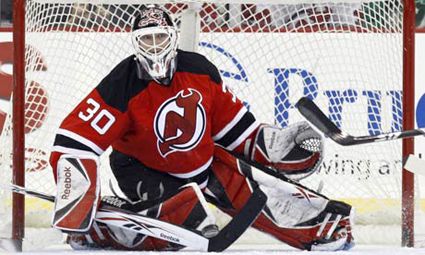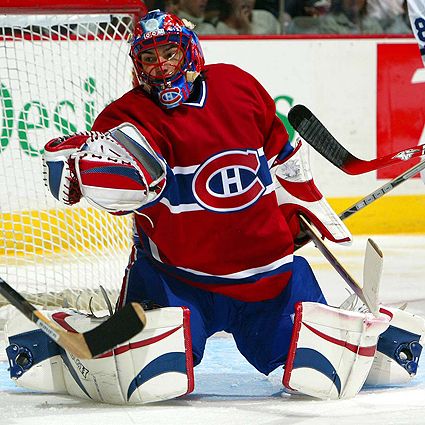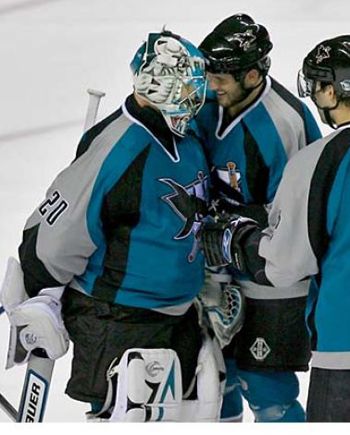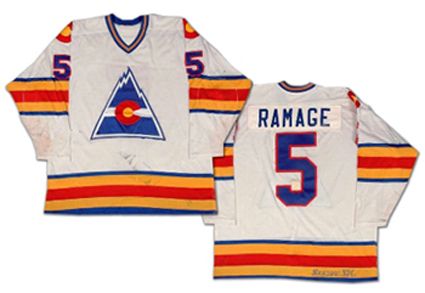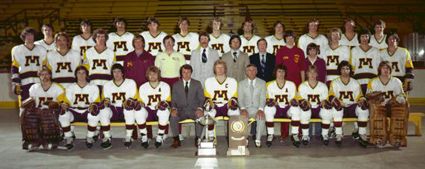
Saturday, December 3, 2011
1986-87 Buffalo Sabres Mike Ramsey Jersey
After graduating from Minneapolis Roosevelt High School, where he was considered the top defenseman in Minnesota, Mike Ramsey, born on this date in 1960, joined the University of Minnesota Golden Gophers for the 1978-79 season.

Mike Ramsey of the Roosevelt Teddies
Ramsey scored 24 points in 34 games as a college rookie as Minnesota would go on to win the NCAA national championship under the guidance of head coach Herb Brooks.

During that season Ramsey also participated in the 1979 World Junior Championships for the United States. Later that spring, Ramsey was chosen 11th overall by the Buffalo Sabres in the 1979 NHL Entry Draft, the first Minnesotan ever taken in the first round.
Rather than return to Minnesota for a second season, Ramsey became the youngest member of the United States Olympic Hockey Team under his college coach Brooks. The Americans shocked the world by upsetting the Soviet Union in the "Miracle on Ice" and then completed their quest by winning the gold medal with a win over Finland.
Ramsey demonstrating his tough defensive style
Following the Olympics, Ramsey immediately turned professional and joined the Sabres for the final 13 games of the season followed by an equal number of playoff games, a total of 89 games played that season including the Olympic Team's training schedule, a huge number of games for someone two years removed from high school hockey.
Ramsey, buoyed by his high pressure Olympic experience against players much older than himself, adapted to the faster and stronger players in the NHL, playing over 150 games in the NHL over the course of the next two seasons. With Buffalo quickly eliminated from the playoffs, Ramsey was free to once again wear the red, white and blue of the United States at the 1982 World Championships.
The 1982-83 NHL season was one of Ramsey's finest offensive seasons, as he scored 8 goals and 38 points while posting a +20 rating. The following season Ramsey's offensive total dipped to 31 points, but he set a career high with 9 goals, as well as having a +27 rating.
Before the 1984-85 NHL season could begin, Ramsey competed in the 1984 Canada Cup tournament, scoring a goal and an assist in six games as the United States
finished second in the round robin portion of the tournament before losing in the semifinals.
Another strong 30 point season followed as Ramsey set a career high with a +31 rating. Two more seasons with Buffalo saw Ramsey extend his streak of 72 or more games played to seven, and set a career high in 1986-87 with 30 points. Ramsey was also named an NHL All-Star in 1987 when the usual All-Star Game format was put on hold as the NHLers faced off against the Soviet Union in the two-game series known as Rendez-Vous '87.
The 1987 Canada Cup came next for Ramsey prior to the 1987-88 NHL season, the first of six more solid defensive seasons with the Sabres which included being named captain of the Sabres in 1991-92. Then, after 14 seasons in Buffalo, Ramsey was traded to the two-time defending Stanley Cup champion Pittsburgh Penguins where he was reunited with his old Sabres coach Scotty Bowman.
There was no third Stanley Cup however, and after playing the following season of 1993-94 with the Penguins, Ramsey signed as a free agent with the Detroit Red Wings. His time there was spoiled by injuries which limited him to just 33 games in 1994-95 and 47 the next.
He retired over the summer, but returned for a pair of games in February of 1996, but felt he wasn't up to standards and retired for good after 18 seasons, 1,070 games, 79 goals and 266 assists for 345 point and but one season with a negative plus/minus rating all while never playing a single game in the minors.
Ramsey played in four NHL All-Star Games and was inducted into the United States Hockey Hall of Fame in 2001.
Today's featured jersey is a 1986-87 Buffalo Sabres Mike Ramsey jersey. This classic Sabres jersey style would remain in use through the 1995-96 season until replaced by an all new look for Buffalo when the team's colors changed to red, black and white. It was brought back as an alternate jersey in 2006-07 and was the basis for a new, modernized alternate in 2008-09 before being promoted to the team's primary jersey in 2010-11, much to the delight of the fans.
Bonus Jersey: Today's bonus jersey is a 1980 United States Olympic Team Mike Ramsey jersey. This blue road jersey was worn during the Americans final game against Finland which clinched the gold medal.
In today's video section, a great clip, as Ramsey levels a Montreal Canadiens player with a clean, hard hit and is then jumped by Mario Tremblay. Not only does Ramsey land a dozen heavy rights, but the two of them would go on to be assistant coaches together with the Minnesota Wild!
Here, Ramsey risks his life and career by actually checking Wayne Gretzky - during the NHL All-Star Game! Yes, he didn't put Gretzky in the fourth row of seats like he could have, but still, it's the last hit we recall in an all-star game!
Finally, here is Ramsey being interviewed a in 2009 between periods of a Minnesota High School girls hockey game in which his daughter Rachel was playing.
Labels:
Buffalo Sabres,
Ramsey Mike,
USA
Friday, December 2, 2011
1925-26 New York Americans Billy Burch Jersey
For the 1925-26 NHL season, the Pittsburgh Pirates would join the league while the Hamilton Tigers were disbanded. In addition to Pittsburgh, a new franchise began play on this date in 1925 as tenants of the brand new (and third) Madison Square Garden in New York City.
The club was founded by Thomas Duggan, who had actually been granted three franchises back in 1923, but was required to wait until the completion of construction of Madison Square Garden before the team could take to the ice. The club, named the New York Americans, benefitted from the demise of the Tigers in Hamilton, when Duggan's financial backer, mobster "Big Bill" Dwyer, who made his fortune as a prohibition bootlegger, bought the rights to the Tigers players to stock the Americans roster.
Their first game, played on this date in 1925, was against fellow expansion brothers the Pirates in Pittsburgh in a contest won by the Americans 2-1 in overtime. Future Hockey Hall of Famer and team captain Billy Burch scored the first goal in team history at 6:12 of the second period, assisted by veteran Ken Randall. Pittsburgh evened the score at 9:45 on a goal by the great Lionel Conacher, who would play a role in Americans team history later on. The third period went by with no scoring, sending the game into an extra period where defenseman Charlie Langlois won the game for New York with an unassisted, short-handed goal at 3:10 to get the franchise off to a fine start.
After four road games to start the season, the Americans would finally play their first game in their new home, which was not originally designed with the ability to create a sheet of ice.
Madison Square Garden in 1925
Duggan arranged for Madison Square Garden owner Tex Rickard to come to Montreal with Dwyer, who would arrange to properly lubricate Tex with some of his underground liquor production before the Canadiens game he was about to witness. The sight of the sold out arena, combined with the dazzling display put on by Canadiens star Howie Morenz suitably impressed Rickard, who agreed to modify the plans for Madison Square Garden to include ice making capabilities on the condition that Morenz be present for opening game. Thus the first opponent hosted by the Americans was none other than Morenz and the Canadiens, who defeated the home team by a score of 3-1 in front of 17,422 curious New Yorkers who saw Morenz seal the victory for Montreal with their third goal at 4:15 of the third period.
A program from the Americans first season
Despite stocking their roster with the players from the first place Tigers club, the team finished fifth out of seven with a 12-20-4 record, led by Burch in scoring with 22 goals, quite nearly one-third of the team's total of 68, and 25 points.
The 1925-26 New York Americans
Still, despite the placing in the standings, the Americans season overall was deemed such a success at the gate that Rickard obtained his own NHL franchise for the 1926-27 season, which would be nicknamed Tex's Rangers. With the addition of not only a second team in Madison Square Garden, but also Chicago and Detroit joining the league, the NHL was split into two divisions, with the Americans being placed in... the Canadian Division! The extra travel over the border took it's toll on the club and they once more finished out of the playoffs with a 17-25-2 record. Burch again led he club in scoring with 19 goals and 27 points, ten more than Conacher, who was obtained from the cash strapped Pirates.
The Americans sank to last in the Canadian Division in 1927-28 with just 11 wins in the face of 27 losses and 6 ties. To make matters worse, the New York Rangers, owned by their landlord Rickard, won the Stanley Cup in only their second year of existence! From the beginning of the two clubs competing for the same fan base. The Rangers, who were coached by the elegant and respected Lester Patrick, became the team of choice for the upper class of Manhattan while the Americans, perhaps tainted by being associated the jailed bootlegger Dwyer, who was arrested 11 days before the Americans first game and spent the entire first season locked up, were the "working class" team, who somehow failed to capture the imagination of the fanbase in the same manner as the stylish and immediately successful Rangers.
Goaltender Roy Worters was obtained from Pittsburgh to solidify the Americans defense, and the club responded with their first winning record, finishing 19-13-12 for second place in their division and their first playoff berth - against their rival Rangers, who won the two-game, total-goals series 1-0 on a dramatic goal at 29:50 of overtime of the second game. Burch led the club in scoring for the third time in four seasons and Worters was named the Hart Trophy winner as league MVP.
The 1928-29 New York Americans
The team plunged to fifth place in the 1929-30 season under new head coach Conacher and missed the postseason for what would be the first of six consecutive seasons. Norman Himes, who led the team in scoring in 1928, set a new club records with 28 goals and 50 points, breaking Burch's mark of 36.
Himes again led the club in scoring in 1931-32, although he came back down to Earth with just 24 points. While the Americans finished "fourth" in the Canadian Division, it was due to attrition, as the Ottawa Senators had not competed that season due to financial difficulties, which meant the Americans actually came in last and missed out on the playoffs for the third season in a row. Additionally, the Pirates had by now moved to Philadelphia for a single, dismal 4 win season and closed up shop for good, unable to survive the Great Depression.
The 1932-33 Americans were led in scoring by Himes for the fourth consecutive season as Worters continued to hold down the duties in goal while their won/loss record continued to slip, now down to 15-22-11, a mark essentially duplicated in 1933-34 at 15-23-10. Eddie Burke led the club offensively with 20 goals and 30 points in 46 games. In hockey sweater news, the Americans introduced a second, white sweater, making them only the second team to have two styles following Toronto in 1927. The struggling team attempted a merger at this point with the equally poor Ottawa Senators, which was turned down by the NHL Board of Governors.
The club had a difficult time in 1934-35 with just 12 wins and their sixth straight, and ninth out of ten seasons of their existence, with no playoffs. Meanwhile, the Rangers not only had yet to have a losing season, made the playoffs in every single one of their now nine seasons and had also delivered a second Stanley Cup by then, which had arrived in 1933.
Another issue for the "Amerks" was Dwyer's inability to recognize the benefits of stability. The club literally had a different head coach every season for their first six seasons, as Tommy Gorman, Newsy Lalonde, Shorty Green, Gorman again, Lionel Conacher and Eddie Gerard all took turns behind the bench until Gerard managed to hold onto the job for two seasons in a row, but only two seasons, as Bullet Joe Simpson then took the helm for three seasons, 1932-33 to 1934-35. Meanwhile, Patrick remained behind the bench for the Rangers' first 13 seasons, and won while doing it, winning 281 games while the Americans would only manged to win 255 during their entire 17 years.
The world turned upside down in 1935-36, as not only did Sweeney Schriner lead both the Americans and the NHL in scoring, but the Americans finally returned to the postseason guided by new head coach and general manager Red Dutton, while the Rangers missed out on the playoffs for the first time in their history! Oddly enough, the Rangers kept their streak of winning records intact at 19-17-12, while the Americans streak of losing records continued for the fifth straight season but it was enough for the Americans to finish third in the Canadian Division to advance to the postseason. They made the most of the opportunity, and defeated the Chicago Black Hawks 3-0 before staying close enough in a 5-4 loss in Game 2 to win their first ever playoff series 7-5 in total goals. Round 2 went to Toronto, who won the best-of-three 2 games to 1.
NHL scoring champion Sweeney Schriner
On the business side of the operation, owner Dwyer, now finding it difficult to pay the bills with the end of prohibition, saw the club taken over by the league. Dwyer was given a second chance, but could not pay off his debts and the league took full control for the 1937-38 season.
After 1936-37, which saw the Americans out of the playoffs once again following a 15-29-4 mark in Worters ninth and final season in goal for the Americans, the club posted only the third winning season in their history when they won 19, lost 18 and tied 11 thanks to Dutton acquiring veterans Ching Johnson and Hap Day.
Ching Johnson
Schriener again led the team in scoring with 21 goals and 8 points and the Americans finally got the best of the Rangers, knocking them out of the playoffs in a hard fought Round 1, winning 2-1 in overtime of Game 1, losing 4-3 in Game 2 before winning Game 3 by a score of 3-2 "on the road" at Madison Square Garden in an epic four overtimes in what was then the fourth longest game in league history and arguably the highlight of the Americans franchise history. Despite winning Game 1 of Round 2 versus Chicago, the Black Hawks rebounded with two straight wins to eliminate the Americans.
The Americans qualified for the postseason with a losing record once more at 17-21-10 thanks to the demise of the Montreal Maroons leaving the NHL as one seven team division, with the top six qualifying for the playoffs. Schriner led the team in scoring for the fourth consecutive season with 44 points but a quick exit from the playoffs followed, as they failed to score a goal in either game against the Maple Leafs.
Financial troubles led to Schriner departing for Toronto in exchange for four players. Also of note, the club acquired the great defenseman Eddie Shore late in the season from Boston. The now 37 year old Shore played the final ten games of his career, as well as three playoffs games, as the Americans scrapped their way to a sixth place finish, with their 15-29-4 record surpassing the Canadiens, who won only 10 times. The Americans drew the Detroit Red Wings, who defeated them 2 games to 1 to end Shore's career. Meanwhile, the Rangers captured their third Stanley Cup, while the Americans had yet to win three playoff series.
Eddie Shore during his brief time with the Americans
The Americans hit bottom in 1940-41 after being forced to sell of their best players in an attempt to stay solvent, coming in a distant last with a dismal 8-29-11 record, the only team to score less than 100 goals and the only to allow more than 147, with 186 against.
Desperate to improve their financial situation, the club changed it's name for the 1941-42 season to the Brooklyn Americans in hopes of connecting with the fans across the East River in Brooklyn despite retaining Madison Square Garden in Manhattan as their home arena due to the lack of a suitable arena in Brooklyn. The team improved record-wise to 16-29-3, but despite scoring 34 more goals while allowing 11 less and improving 8 points in the standings, the Americans finished last in the NHL and missed out on the playoffs once again.
With the arrival of World War II, the Americans were hit harder than most due to their already weak financial position. With many players off to serve in the war, combined with travel restrictions and Dutton's inability to actually relocate the team to Brooklyn, the team suspended operations with the intent of regrouping and coming back after the war. Despite an effort to build a new arena in Brooklyn as a home for the team in 1945, the NHL finally cancelled the franchise formally in 1946. The departure of the Americans from the NHL after the 1941-42 season formally began the "Original 6" era, as no new franchises would begin play until 1967 and metropolitan New York would not have a second team again until 1972 with the arrival of the New York Islanders.
In all, the Americans played 17 seasons, qualifying for the playoffs just five times despite only three winning records in their history.
Today's featured jersey is a 1925-26 New York Americans Billy Burch jersey as worn during the Americans inaugural season. When the Americans took to the ice, it was in their new, star-spangled sweaters, unlike any seen before in the NHL, and we dare say ever since, thanks to it's more than three dozen stars.
The Americans first wore their star spangled sweaters for all games during their first eight seasons, either home or road, before adding a white alternate jersey in 1933. They would wear both jerseys through the 1937-38 season, which was the last for the original stars and stripes jersey. For their final four seasons, only the white jerseys were worn for all games.
Today's video is a look at the history of the New York Americans.
Labels:
New York Americans
Thursday, December 1, 2011
1940-41 Chicago Black Hawks Bill Carse Jersey
In what was an otherwise ordinary regular season NHL contest held on this date in 1940, not one, two or even three sets of brothers took to the ice, but four pairs of siblings skated in the New York Rangers game against the Chicago Black Hawks.
Lacing up the skates for the Rangers were Neil and Mac Colville and Lynn and Muzz Patrick. Taking the ice for the Black Hawks were Max and Doug Bentley and Bob and Bill Carse.
Neil Colville first made it to the NHL in 1935 with the Rangers for a single game and then played with them full time through the 1941-42 season as a center which included winning the Stanley Cup in 1940. His career was interrupted by World War II and it would not be until 1944-45 that he would again play for New York for just 4 games. While away from the Rangers he continued to play senior hockey, winning the Allan Cup while a member of the Canadian army's Ottawa Commandos in 1942. He returned to the blueshirts full time in 1945-46, only as a defenseman, and played four additional seasons before closing out his career with two seasons with New Haven of the American Hockey League. Neil totaled 464 games with 99 goals and 265 points in 12 NHL seasons. He was just as talented on defense as he was on offense, becoming the first player to be named to NHL All-Star teams as both a forward and a defenseman. He was later inducted into the Hockey Hall of Fame in 1967.
Mac Colville, a year and a half younger than Neil, had a nearly identical career path as his brother, also first joining the Rangers in 1935 and playing right wing with Alex Shibicky on left wing and brother Neil as the center. He too won a Stanley Cup in 1940, had his career interrupted by military service by World War II, was part of the Allan Cup winning Ottawa Commandos in 1942 and returned to the Rangers for parts of two seasons after the war, this time playing defense. His final NHL totals were 353 games, 71 goals and 175 points.
Murray "Muzz" Patrick, son of the legendary Lester Patrick, joined the Rangers in 1937-38 for a single game before an NHL career that would last four seasons on defense. He too, was a member of the 1940 Stanley Cup champion Rangers squad and had his career interrupted by World War II. He returned for 24 games, but was unable to compete at the highest level after being away from the game for four years and later became the Rangers head coach in 1953.
Lynn Patrick, also a son of Lester and three years older than Muzz, was a left winger who joined the Rangers in 1934-35. He played nine seasons with the Rangers, winning the Stanley Cup in 1940. His career high was 32 goals in 1941-42 and his highest point total was 61 the following season. He too, was away from the game for two seasons and returned for the 1945-46 season for the final NHL campaign of his career which totaled 455 games, 145 goals and 335 points. He later became an NHL general manager and was inducted into the Hall of Fame in 1980.
On the other side of the ice was Max Bentley, whose long career began in 1940-41. He played center and was a member of the Black Hawks for six seasons, cut short by losing two seasons due to World War II, before a blockbuster trade sent him to the Toronto Maple Leafs where he played for six seasons as well. His final NHL season was spent with the Rangers. He was a consistent offensive force, who had a career high of 31 goals in 1946 with Chicago when his 61 points led the league in scoring, as well as two seasons of 70 points or more, capped with 72 in 1947 to lead the NHL in scoring once again. His final totals show 645 games played, 245 goals and 544 points. He won the Hart Trophy in 1946 and the Lady Byng in 1943 and was inducted into the Hockey Hall of Fame in 1966.
Doug Bentley joined Chicago in 1939. A left winger, Doug led the NHL in scoring with 73 points in 1943, which equalled the NHL record. In 1943, brother Reg joined Max and Doug on a line for Chicago, which included Reg's only NHL goal, assisted by both of his brothers, the only time in league history three brothers combined for a goal and both assists. He led the NHL in goals with 38 in 1944 before missing a season due to the war. Following his return, he was teamed with Max and Bill Mosienko to form "The Pony Line", so named due the trio all being small and quick. After the departure of his brother Max, Doug played for more seasons in Chicago through the 1951-52 season. He continued to play in the Western Hockey League for six additional seasons, which included 20 games with the Rangers in 1953-54. His final NHL totals were 565 games played, 219 goals and 543 points. He was inducted into the Hockey Hall of Fame in 1964.
Left winger Bob Carse came out of Edmonton and made it to the NHL in 1939. He played four seasons with the Black Hawks before World War II put his career on hold as well. When he returned to pro hockey in 1946 he did manage another 22 NHL games in 1947-48 with the Montreal Canadiens as part of four seasons he spent with the Cleveland Barons in the AHL. Bob totaled 165 games, 32 goals and 87 points during his career.
Bill Carse, also a left wing, made it to the NHL in 1938 with the Rangers for a single game and joined the Black Hawks the following season to begin a three year run with the team. After 122 games, 28 goals and 71 points, World War II interceded in his career path as well. After three years away from the game, he played for seasons with the Pacific Coast League's Vancouver Canucks.
The game itself was played at the Chicago Stadium in front of 16,208 fans, the largest attendance league wide at any game that season up to that point. Chicago opened the scoring with a pair of goals in the first period and again in the second to lead 3-0 after two periods. The Rangers scored midway through the third period to give hope of a comeback, but sealed the victory with a goal in the final minute of the game for a 4-1 win.
Max Bentley, who was a rookie in 1940-41, scored the opening goal at 4:25 before Bill Carse added the second Chicago goal of the period at 14:59. The rest of the siblings involved in the contest were kept off the scoresheet that evening.
By the end of the season, Doug Bentley finished with 28 points, good for third on the Black Hawks. Bill Carse finished with 20 points and Bob Carse with 18, just edging rookie Max Bentley's 17. Meanwhile in New York, Lynn Patrick outscored the rest of the siblings with 44 points, which tied for the team lead. Neil Colville was just behind with 42 and brother Mac Colville finished with 31, while defenseman Muzz Patrick registered 10 points in all.
Today's featured jersey is a 1940-41 Chicago Black Hawks Bill Carse jersey. The Black Hawks adopted the barberpole style in 1937-38 and remained in use through the 1954-55 season, although with some changes to the crest and adjustments to the striping pattern along the way.
The Blackhawks chose this style jersey as their turn back the clock jersey for the NHL's 75th Anniversary season in 1991-92, reviving a truly distinctive style that many fans were not even aware of, as throwback styles were uncommon, if not unheard of in the NHL at the time.
Fortunately for the seamstresses of the day, player names were still a long way off, as the siblings would have required a fair amount of extra sewing for first initials, or even first names in the case of Bob and Bill Carse.
While many brothers have played in the NHL, some as teammates and even won the Stanley Cup together, many others have played against each other as opponents, some of whom have even fought each other, but perhaps the most famous brothers in hockey history never played in the NHL...
Wednesday, November 30, 2011
1980-81 Minnesota North Stars Bobby Smith Jersey
Bobby Smith had an outstanding junior career with the Ottawa 67's, including scoring 135 points in 64 games in 1976-77 and following that with 192 points in 61 games the next season - over a three point per game average! His 123 assists and 192 points still stand as OHL league records.
Smith was subsequently drafted first overall by the last place Minnesota North Stars in the 1978 Amateur Draft and went on to capture the Calder Trophy following a rookie campaign in which he scored 30 goals and 74 points in 80 games.
Interestingly, the North Stars used their second round pick in 1978 to draft Smith's Ottawa 67's linemate Steve Payne. Further picks that year would net 1980 USA Olympic team member Steve Christoff and eventual team captain Curt Giles.
Prior to Smith's rookie season, the NHL allowed a deal where the Cleveland Barons owners George and Gordon Gund were allowed to merge their franchise with the North Stars franchise under the Gund's ownership and would play as the North Stars in the Baron's place in the Adams division. This allowed the North Stars to add players such as Mike Fidler, Al MacAdam, Greg Smith and reacquire fan favorite J. P. Parise and goaltender Gilles Meloche.
The North Stars were able to show a 25 point improvement in the standings, but failed to qualify for the playoffs in the rugged Wales Conference despite having 5 more points than the Vancouver Canucks of the Campbell Conference.
Further additions in the 1979 Entry Draft would net the North Stars Craig Hartsburg, Tom McCarthy, Minnesota native and 1980 USA Olympic team member Neal Broten, who would join the team the following season.
This influx of talent over the course of two seasons paid off in 1979-80, as MacAdam, Payne and Smith all topped 80 points during the regular season and the North Stars qualified for the playoffs after a 23 point improvement in the standings. The North Stars would eliminate the Toronto Maple Leafs in three straight, gain invaluable confidence and experience by defeating the Montreal Canadiens in seven games before losing to the Philadelphia Flyers in round 3.
Smith would increase his regular season point total to 83 games that season and add another 14 points in 15 playoff games.
Growing in confidence and experience, Smith would once more improve his point total with 93 points in 1980-81 and, coming off the playoff run of the previous season, the North Stars would make a run through the playoffs, aided by the additions of Gordie Roberts, Dino Ciccarelli and the late season arrival of Broten just in time for the playoffs.
The North Stars would sweep their previous nemesis the Boston Bruins, easily dispatch the Buffalo Sabres in five games, eliminate the Calgary Flames in six before running into the midst of the New York Islanders dynasty in the finals to complete their unusual journey from last place to the Stanley Cup Finals in just three seasons.
Smith's finest season as a professional would come in 1981-82 with 43 goals and 71 assists for 114 points, the fourth consecutive increase in points during his four seasons in the league. The following season would see his point total drop to 77 and the North Stars would be bounced out of the playoffs despite a club record 96 points in the second round by arch-rivals the Chicago Black Hawks.
A falling out with new North Stars coach Bill Mahoney led to Smith being dealt to the Montreal Canadiens, where he would play for the next seven seasons, scoring as many as 93 points in 1987-88 and winning the only Stanley Cup of his career in 1986 when he finished second in Canadiens regular season scoring and contributed 15 points in 20 playoff games. The Canadiens would make the finals again in 1989 and Smith would contribute 19 points in 21 games that year.
Smith was dealt back to Minnesota in time for the 1990-91 season and help the North Stars on an improbable run through the playoffs, as they defeated the President's Trophy winning Chicago Blackhawks (who finished 38 points ahead of them in the standings) in the first round, the St. Louis Blues (37 points ahead) and Edmonton Oilers (12 points better) before falling to the Mario Lemieux-led Pittsburgh Penguins in the finals.
Smith wore #18 on his return to Minnesota
Smith would play two more seasons in the NHL, which included his 1,000th NHL point on this date in 1991, becoming only the 32nd player in league history to reach that mark. Later that season he reach the 1,000 game mark and would eventually retire with 1,077 games played, 357 goals and 679 assists for 1036 points and 160 points in 184 career playoff games and one Stanley Cup.
Internationally, Smith would play in the 1978 World Junior Championship as a teammate to Wayne Gretzky, the year Canada wore blue jerseys, and win a bronze medal and then again in the World Championships in 1979 and in 1982 when he would earn a bronze medal.
Today's featured jersey is a 1980-81 Minnesota North Stars Bobby Smith jersey worn during the era when defenseman Greg Smith was also a member of the North Stars. But rather than go with the usual, expected "B. SMITH" and "G. SMITH" to identify the pair, the North Stars, for some unexplained reason, chose to put the full name "BOBBY SMITH" on Bobby's jersey, despite the full name treatment usually reserved for brothers whose names began with the same letter, such as Rich and Ron Sutter, Dave and Don Maloney, Jim and Joe Watson or Mark and Marty Howe. We assume Greg received the same full name treatment, but were unable to confirm this.
After the departure of Greg Smith following the 1980-81 season, Bobby Smith had just the standard surname only on his jersey, but on his return to the North Stars from his time in Montreal, the arrival of former Philadelphia Flyer Derrick Smith in 1991-92 saw Bobby's jerseys identified as "B SMITH" this time around.
Bonus Jerseys: Today's bonus jerseys is a 1991-92 Minnesota North Stars Bobby Smith jersey from the season Smith played in his 1,000th game. This jersey is from the Norm Green ownership era after the club changed their traditional green jerseys to black, along with a more generic team logo, which de-emphasized the "North" part of the club's name, foreshadowing the club's move to Dallas in time for the 1993-94 season.
This jersey features both the NHL 75th Anniversary patch and the Minnesota North Stars 25th Anniversary patch. The club started out the season with just the NHL 75th patch before later adding the North Stars 25th Anniversary patch to the left shoulder.
Bobby Smith wore "B SMITH" on his jersey due to left winger Derrick Smith being a member of the North Stars during the final two seasons of Bobby's career.
Bobby Smith wore "B SMITH" on his jersey due to left winger Derrick Smith being a member of the North Stars during the final two seasons of Bobby's career.


When on his game, Smith could dominate a game and was famous for his wraparound goals made possible by his long reach.
Here is footage from the night the North Stars finally stood their ground against the Boston Bruins in 1981 at the Boston Garden, an arena they had never won a game in - ever - dating back 14 seasons to the North Stars inception in 1967. While they lost this game, they made a statement that they were not going to be intimidated any longer, having recently had John Wensink challenge the Minnesota bench during a game. This stand was a turning point for the franchise and they proceeded to knock the Bruins out of the playoffs later that season, which included two victories in Boston, and were on their way to the Stanley Cup Finals for the first time ever.
Bobby Smith helped kick off the mayhem seven seconds into the game with a fight against the Bruins Steve Kasper while linemate Steve Payne fought Keith Crowder.
There were further fights at 3:35, 8:06 and a bench clearing brawl at 8:58 of the first period which involved fights in the runway back to the dressing rooms and the police trying to intervene. There were three more fights in the second period and two more in the third as the teams set a then NHL record with 406 penalty minutes.
Labels:
Minnesota North Stars,
Smith Bobby
Tuesday, November 29, 2011
1924-25 Victoria Cougars Jack Walker Jersey
Born on this date in 1888, Jack Walker grew up and began playing hockey in Port Arthur, Ontario. His first team was the Port Arthur East Greys of the New Ontario Hockey League in 1905-06. After one more season with the East Greys, Walker joined the Port Arthur Lake City club in the same NOHL for the 1907-08 season.
A forward, Walker started slowly with 3 goals in 6 games his first season with Lake City, a total which increased to 8 goals in 12 games the following season before he found his game with 20 goals in 12 games in 1909-10 and added one and a half times that many in 1910-11 with 30 goals in 14 contests while leading the team to their second consecutive league championship. Following the season he got his first taste of Stanley Cup competition when Port Arthur challenged the Ottawa Hockey Club in a single elimination game, which the famed Silver Seven won handily 13-4, with Walker scoring one of the goals for Port Arthur.
Walker played one final season for Lake City with 17 more goals before attracting attention from the growing professional leagues of the east. He began the 1912-13 season with the brand new Toronto Blueshirts (who would eventually become the Maple Leafs in 1927) of the National Hockey Association, but left for the defending league champion Moncton Victorias of the Maritime Professional Hockey League after just a single game in Toronto. With the Victorias, Walker totaled 21 goals in 15 games, which proved to be the final season for Moncton, and Walker rejoined Toronto for the 1913-14 season.
It proved to be a shrewd move, as Toronto tied for first place in the NHA with a 13-7 record and defeated the Montreal Canadiens 6-2 in a two game series to earn the right to challenge for the Stanley Cup, taking on the Victoria Aristocrats of the Pacific Coast Hockey Association in a best-of-five series. Toronto won all three contests to sweep the series and earn Walker his first Stanley Cup as well as a bonus of $297.
1914 Stanley Cup champion Toronto Blueshirts
He returned to the Blueshirts for the 1914-15 season, in which he scored a dozen goals in 19 games. The rivalry between the NHA and PCHL was in full swing at this point, and Frank and Lester Patrick signed all but one of the Blueshirts to stock the roster of the newly created Seattle Metropolitains PCHL franchise, which included Walker.
During his second season with Seattle of 1916-17, the club would win the PCHL title with a 16-8 record which earned them the right to compete for the Stanley Cup against the Montreal Canadiens of the NHA. Montreal won Game 1 by a score of 8-4 before Seattle's defense dug in, allowing just one goal in each of the three remaining games easily by scores of 6-1, 4-1 and finally a 9-1 blowout to become the first American club to win the Stanley Cup, the second of Walker's career. The Seattle Daily Time wrote "The lexicon of sport does not contain language adequate to describe the fervor of the fans." following the Metropolitans victory.
The 1916-17 Stanley Cup champion Seattle Metropolitans
Two seasons later Walker and the Metropolitains would again advance to the Stanley Cup Finals by defeating the Vancouver Millionaires in the PCHA playoffs. Seattle once again found the same Montreal Canadiens as their opponents, who they demolished 7-0 in Game 1. Montreal rebounded with a 4-2 win in Game 2 but Seattle responded with another strong performance with a 7-2 win in Game 3. Game 4 ended in a scoreless tie and then the Canadiens eked out a 4-3 win at 15:57 of overtime to even the series at 2-2-1 heading into Game 5. Only Game 5 was never played, as several of the Canadiens were admitted to the hospital feeling the effects of the influenza epidemic, which had arrived on Canada's west coast, causing the game to be cancelled and the series permanently suspended. After spending nine days in the hospital, Bad Joe Hall of Montreal died of his illness.
The Stanley Cup engraving for 1919 reads "Series not Completed"
Seattle won the PCHA regular season and playoffs again in 1919-20 to make the Metropolitains third Stanley Cup appearance. This time they traveled east to face the Ottawa Senators, where they lost the first two games of the best-of-five series before winning Game 3 on the slushy ice in Ottawa, where the arena did not have the capability to make artificial ice. The series moved to Toronto where the Metropolitans forced a deciding Game 5 with a 5-2 win to even the series at 2 games each. The Senators denied Walker another cup with a 6-1 victory to close out the series.
In all, Walker would play all nine seasons of the Metropolitans seasons from 1915-16 to 1923-24, which included five first place finishes and three league playoff championships and one Stanley Cup. While with Seattle, Walker would play in 186 games and score 82 goals with a high of 18 in his final season with the club on his way to leading them in scoring with 23 total points. He would finish as the third leading scorer in Metropolitans history despite being better known for his aggressive defensive play.
With the Metropolitans, as well as the PCHA, no longer in business, Walker signed with the Victoria Cougars, who had moved from the PCHA to the Western Canada Hockey League. While the Cougars had a moderately successful regular season, finishing third with a 16-12 record, they defeated Saskatoon on the league semifinals before defeating the Calgary Tigers 3 goals to 1 in the finals. Their playoff run continued as they now faced the Canadiens, who by now had joined the new National Hockey League. Games 1 and 2 went to Victoria 5-2 and 3-1 before Montreal stayed alive in their best-of-five with a 4-2 win in Game 3. Victoria then became the final team outside of the NHL to win the Stanley Cup when they dominated Game 4 by a score of 6-1 to earn Walker his third Stanley Cup with his third different team as a member of three different leagues, still one of only ten men to ever with the cup with three different clubs, along with teammate and goaltender Hap Holmes who was with him for all three.
The 1924-25 Stanley Cup champion Victoria Cougars
Walker would play one more season with the Cougars in Victoria for the 1925-26 season before the roster was sold to interests in Detroit who were starting up a new NHL franchise for the 1926-27 season. In honor of their roster coming from the Victoria Cougars, the new Detroit ownership named their new club the Detroit Cougars. After enjoying nine years of stability with the Metropolitans, Walker was now playing for his third different club in his third different league in four seasons.
He played two seasons in Detroit and then returned to Seattle, where a new club, the Seattle Eskimos of the brand new Pacific Coast Hockey League was just beginning. The team and league lasted three seasons, with Walker competing in all three and earning the league's MVP trophy.
He spent two more seasons coaching and occasionally playing in a league in California to wind down his career, which spanned over 25 years and saw hockey grow from it's amateur days, to the beginnings of professionalism, the expansion to the west and formation of the NHL and it's expansion into the United States., While Walker only played 80 games in the NHL, his career was a long and successful one, which saw him win three Stanley Cups and gain induction into the Hockey Hall of Fame in 1960.
Today's featured jersey is a 1924-25 Victoria Cougars Jack Walker jersey. The Cougars began life in 1911 original members of the Patrick's PCHL. Two seasons later they adopted the name Aristocrats until 1916. With the outbreak of World War I, their arena was taken over by the Canadian military, which forced a move to Spokane, Washington as the Canaries for a year, after which the club folded.
The franchise was revived in 1918 as the Aristocrats and once again changed their name, this time to the Cougars in 1922 for their final four seasons, during which they became the final team not a member of the NHL to win the Stanley Cup.
Monday, November 28, 2011
1980-81 New York Islanders Billy Smith Jersey
NHL history was made on this date in 1979, when Rob Ramage of the hapless Colorado Rockies, while on a delayed penalty call, would send the puck back to the point anticipating a Rockies teammate would be stationed there, only to find the point vacated and the puck making the long journey down the length of the ice and right into the Rockies goal and the record books.
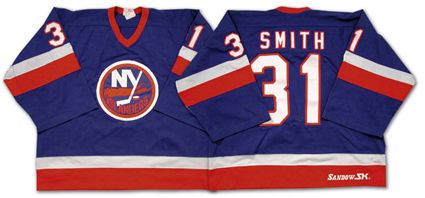
Since Islanders goaltender Billy Smith was the last Islander to touch the puck, he was the official scorer of the goal, the first one credited to a goaltender in NHL history.
Ron Hextall became the first goaltender to legitimately aim for the net and score a goal in the NHL eight years later on December 8, 1987 when he scored against the Boston Bruins, who had pulled goaltender Rejean Lemelin for a sixth attacker who was apparently not in any way a sixth defender.
Hextall scored a second goal during the playoffs on April 11, 1989 versus the Washington Capitals, entering the record books as the first goalie to score during the playoffs.
Chris Osgood of the Detroit Red Wings added his name to the list of goaltenders who have scored on March 6, 1996 with a shot the length of the ice in Hartford versus the Whalers.
April 17, 1997 would see the first of Martin Brodeur's two goals, as he would fire one in against the Montreal Canadiens. Brodeur would be credited with his second goal, despite being about 125 feet from the puck when a mishandled puck by a Philadelphia Flyer at his own blueline found it's way into the unguarded Flyers net on February 15th of 2000.
Jose Theodore, then of the Montreal Canadiens would score with style on January 2, 2001 with a backhand shot, as he launched the puck the length of the ice on Long Island against New York in the process of shutting out the Islanders, the only goalie to shoot the puck into the goal and record a shutout in the same game.
Evgeni Nabokov joined the scoring ranks on March 10, 2002 when he fired one in against the Vancouver Canucks in Vancouver for the sixth and most recent goalie to purposely shoot the puck into the opposing goal.
Damian Rhodes of the Ottawa Senators (1999), Mika Noronen of the Buffalo Sabres (2004) and Chris Mason of the Nashville Predators (2006) would all receive credit for goals of the Billy Smith variety, as the opponents would all misfire in some manner and send pucks down the ice and into their own nets.
Today's featured jersey is a 1980-81 New York Islanders Billy Smith jersey, the same style he was wearing when he "opened the floodgates" of goalies scoring in the NHL.
In addition to going into the history books as the first goalie to score a goal, Smith did manage to accumulate four Stanley Cups during the early 1980's while with the New York Islanders dynasty.
This particular style of jersey with the white and orange sleeve stripes was first introduced for the 1978-79 and used through the 1983-84 season before the Islanders changed the specification of the names on the back from two-color to single color white names. The appearance of the "Sandow SK" branding on the rear hem was one of the earliest instances of manufacturer logos appearing on NHL jerseys, which began only the season before and was the first season ever on an Islanders jersey.

Bonus Jersey: Today's bonus jersey is a 1980-81 Colorado Rockies Rob Ramage jersey. Ramage's errant pass led to Smith being credited with the first goal ever scored by a goaltender.
The Rockies wore the same jerseys for their six years in Colorado before moving to New Jersey, with the only notable change being adding names to the backs of their blue road jerseys for their second season of 1977-78.
Here is the play on which Billy Smith was credited with the first goal ever scored by an NHL goalie.
The Rockies wore the same jerseys for their six years in Colorado before moving to New Jersey, with the only notable change being adding names to the backs of their blue road jerseys for their second season of 1977-78.
Here is the play on which Billy Smith was credited with the first goal ever scored by an NHL goalie.
Here is a wonderful compilation of all the goals scored by goalkeepers in the NHL, several of which are direct shots by the goalies themselves, and not "own goals" on the part of the other team. Be warned, the volume varies quite a bit from clip to clip!
The last video today is a look at the career of Billy Smith from the "Greatest Hockey Legends" series.
Labels:
New York Islanders,
Smith Billy
Sunday, November 27, 2011
Cyber Monday Deals
Be sure to take a look at our right hand column for the many promotions our advertisers are running for Cyber Monday. There are some great deals to be had!
30% OFF a $30 order at lids.com & lids.ca Monday ONLY! Use code 30OFF30. Exp 11:59pm EST. Cannot combine w/ other offers or clearance.
In addition to our sponsors, we are also having a sale ow through Christmas, as all items in our Third String Goalie online shop have been discounted! Third String Goalie branded goods proudly featuring the Patron Saint of Goaltenders Georges Vezina. Products available include sweats, hoodies and t-shirts for men, women and kids, coffee mugs and travel mugs as well as items for the home and office. We've got something for everyone!

In addition to those sales, Roots is having a special 25% off sale which is enhanced by free shipping!
We've also welcomed a new advertiser, Kaskey Kids, whose line of sports action figures are sure to be popular with the young ones and hockey is part of their lineup of football, baseball and soccer figures.
Speaking of kids, we have added a selection of hockey related items we're sure the young ones will enjoy, which are viewable below.

Thanks for your continued support of Third String Goalie, and we encourage you to patronize our advertisers, who we have personally selected for inclusion on our website based on doing successful business with many of them ourselves.
Subscribe to:
Comments (Atom)

